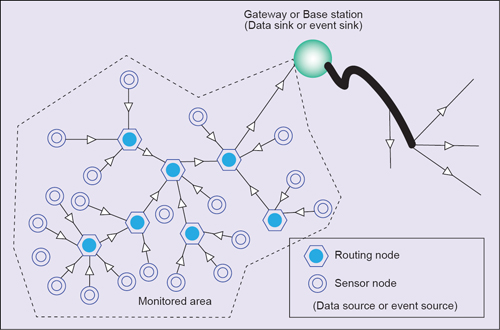A wireless sensor network (WSN) is a communication system which senses and gathers information from a certain area and sends it to different places of its choice. In other words, WSN connects physical world to virtual world. In such networks the communication system requires networking protocols that are efficient, reliable, scalable and secure.
WSNs can be very useful for target detection and identification by military, and for environmental applications like agricultural farm monitoring and forest fire monitoring. Sensors integrated into structures, machinery and the environment, coupled with efficient delivery of sensed information, could provide tremendous benefits to society, such as fewer catastrophic failures, conservation of natural resources and improved manufacturing productivity.
These applications require a good quality of service (QoS) from sensor networks, such as, minimum percentage of sensor coverage in the required area, continuous service during required time slot with minimum (or limited) resources (like sensor energy and channel bandwidth) and minimum outside intervention. The sensors may vary from miniature in-built sensors to external sensors like video cameras and position sensors.

WSNs have witnessed tremendous growth recently because of their location-independent sensing capabilities even in inaccessible and dangerous regions, low cost of sensors and long life of power supply because of low power consumption.
The WSN is a variant of ad-hoc networks and differs from ad-hoc networks because of its constraints and unique features. Ad-hoc network means each sensor supports a multi-hop routine algorithm (several nodes may forward data packets to the base station). The WSN lifetime is dependent on the available energy, so energy routing protocol is desired, which can significantly prolong the life-time of WSN. A WSN requires collaboration among multiple types of sensors with different specifications, thus forming a heterogeneous WSN.
Wireless technologies aim at achieving ambient intelligence. Mobile devices embedded in homes, offices and public places enable ubiquitous sensing, computing and communication. Mobility also implies that limited size and restriction on power consumption, seamless connectivity with other devices and fixed networks, and increased data rates are the bare minimum necessities for intelligent systems.
Features of WSNs
Following are some unique features of WSNs:
1. Sensor nodes are typically immobile
2. WSNs may be deployed in harsh environments, so failures may be quite common
3. The WSNs may be very small, thereby requiring smaller batteries which are bound to have short life-time. So WSNs may have less computational power and less memory
4. Location information only
5. Communication is typically data-centric rather than address-centric, meaning routing may be aggregated/compressed/prioritised, even dropped, depending on the contents of the data
6. Communication in WSN takes place in very short packets to reduce overheads
7. Sensor networks have many-to-one traffic pattern, which may create hot-spot problems
Incorporating and taking care of the above features plays a tremendous role in designing protocols for efficient utilisation of the limited resources. Sensor networks operate under light load and suddenly become active in response to events like fire outbreak, earthquake or enemy movement.
WSN architecture
WSNs are a type of wireless networks that have three main components: large number of arbitrarily distributed sensor nodes, sink nodes (also known as base station or gateway) and software (see Fig. 1). Each node has a single omni-directional antenna. Two sensors are neighbours if they are in transmission range of each other and can directly communicate with certain reliability. The gateway is located at the boundary of the monitored area, where it is reachable by at least some sensors and connects the micro-sensor network to the outside.
We refer to each micro-sensor as a data source or an event source and the gateway as a data sink or an event sink. The data is collected at the wireless sensor node, compressed and transmitted to the gateway directly or, if required, uses other wireless sensor nodes to forward data to the gateway. The transmitted data is then presented to the system by the gateway connection. The architecture of a micro-sensor contains four components: sensing circuitry, digital processing, power supply and radio transceiver.
Sensing circuitry. A wireless sensor node contains sensing and analogue-to-digital circuitry, which senses the surrounding environment and transforms it into electrical signals. The sensed data may be about the behaviour of moving objects or static information like temperature, pressure and humidity. The position of the individual sensors cannot be predetermined. For example, the monitoring fields could be hostile or dangerous and may not be accessible in case of forest fire, chemical pollution, ongoing battle, etc.
A sensor network contains thousands of sensors, which are randomly and densely deployed (10 to 20 sensors per square metre). The sensors’ range is not always a perfect circle, it could be an elliptical or some other shape. The sensing strength could vary with distance from the sensor. The development of sensor nodes equipped with Flash memory is giving a new direction in designing and deploying energy-efficient WSNs.
Sensor nodes can be imagined as small computers having limited computational power and limited memory. They consist of processing unit with sensors, designed to compute, calculate and distribute to communication device (transceiver or optical) power source).








